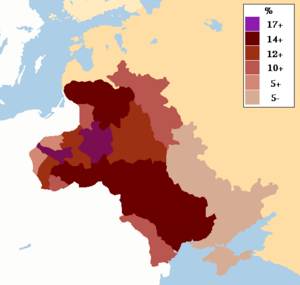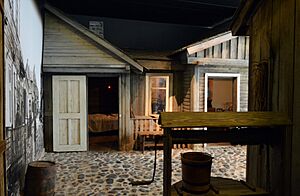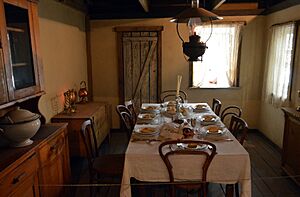Shtetl facts for kids
A shtetl (pronounced SHTET-uhl) was a small town or village where many Jewish people lived in Eastern Europe. These unique communities were common before World War II. The word "shtetl" comes from Yiddish, which is a language spoken by many Jewish people from that region.
Contents
What Was a Shtetl Like?
Shtetls were usually small, with a few thousand people living there. Most of the people were Jewish, but non-Jewish neighbors also lived nearby. Life in a shtetl was very focused on Jewish traditions and religion.
Daily Life in a Shtetl
People in shtetls often lived simple lives. They worked as merchants, craftspeople, or teachers. Many families were close-knit, and the community helped each other. The main street often had shops and a market.
Homes and Buildings
Homes in shtetls were usually small and made of wood. They were often built close together. The most important building was the synagogue, which was a place for prayer and community gatherings.
Culture and Traditions
Shtetls were centers of Jewish culture. People spoke Yiddish, and traditional music, called Klezmer, was very popular. Festivals and holidays were important times for the community to come together.
Where Were Shtetls Found?
Most shtetls were located in a part of Eastern Europe known as the Pale of Settlement. This area included parts of modern-day Ukraine, Belarus, Poland, Lithuania, and Moldova. Jewish people were often only allowed to live in this specific region.
Why Did Shtetls Change?
Life in the shtetls began to change in the late 1800s and early 1900s. Many young people moved to bigger cities or to other countries like the United States. They were looking for more opportunities.
The End of the Shtetls
The biggest change happened during World War II. The Holocaust, which was a terrible event where millions of Jewish people were killed, destroyed almost all the shtetls. The communities and their unique way of life were tragically lost.
Shtetls Today
Today, very few original shtetls remain. However, their memory and culture are still important. Museums and books help us remember what life was like in these special towns.
See also
 In Spanish: Shtetl para niños
In Spanish: Shtetl para niños





